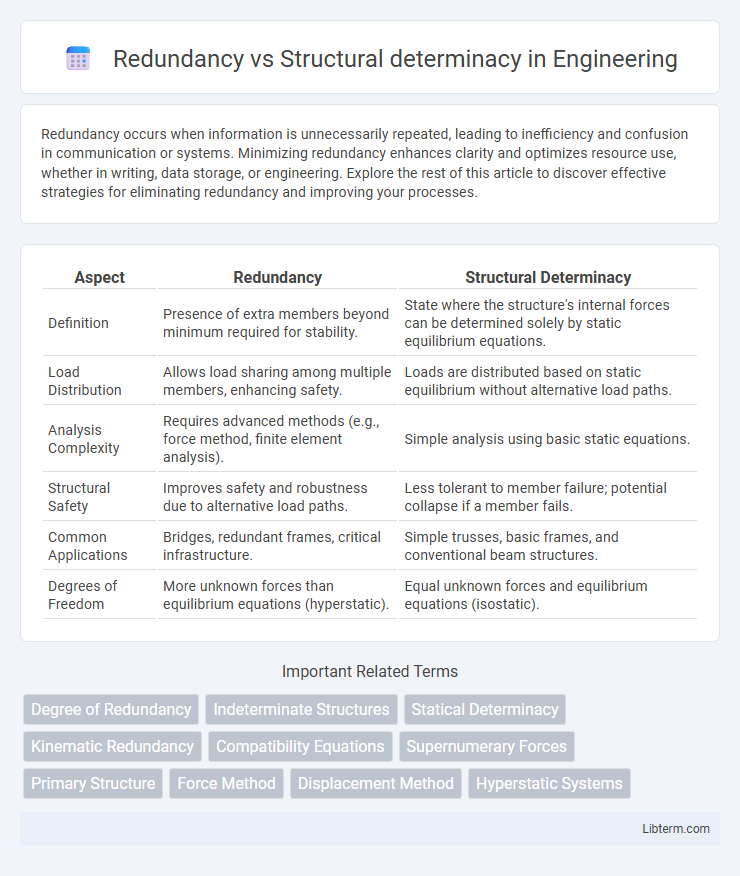Redundancy occurs when information is unnecessarily repeated, leading to inefficiency and confusion in communication or systems. Minimizing redundancy enhances clarity and optimizes resource use, whether in writing, data storage, or engineering. Explore the rest of this article to discover effective strategies for eliminating redundancy and improving your processes.
Table of Comparison
| Aspect | Redundancy | Structural Determinacy |
|---|---|---|
| Definition | Presence of extra members beyond minimum required for stability. | State where the structure's internal forces can be determined solely by static equilibrium equations. |
| Load Distribution | Allows load sharing among multiple members, enhancing safety. | Loads are distributed based on static equilibrium without alternative load paths. |
| Analysis Complexity | Requires advanced methods (e.g., force method, finite element analysis). | Simple analysis using basic static equations. |
| Structural Safety | Improves safety and robustness due to alternative load paths. | Less tolerant to member failure; potential collapse if a member fails. |
| Common Applications | Bridges, redundant frames, critical infrastructure. | Simple trusses, basic frames, and conventional beam structures. |
| Degrees of Freedom | More unknown forces than equilibrium equations (hyperstatic). | Equal unknown forces and equilibrium equations (isostatic). |
Understanding Redundancy in Structural Engineering
Redundancy in structural engineering refers to the presence of additional components or supports beyond the minimum required for stability, enhancing a structure's ability to withstand unexpected loads or damages. It is a critical factor distinguishing statically indeterminate structures from statically determinate ones, where redundancy increases safety by providing alternative load paths. Understanding redundancy helps engineers design more robust, resilient structures capable of maintaining integrity under stress or damage.
Defining Structural Determinacy
Structural determinacy refers to a property of a structural system where the internal forces can be uniquely determined solely from the equilibrium equations without considering material properties or deformation compatibility. It contrasts with redundancy, which occurs when extra members or supports create multiple load paths, making equilibrium equations insufficient for unique force determination. Understanding structural determinacy is essential for analyzing stability and ensuring the structure's load-bearing capacity can be accurately computed.
Key Differences Between Redundancy and Determinacy
Redundancy in structural engineering refers to the presence of additional supports or members beyond what is necessary for equilibrium, providing alternative load paths and enhancing safety. Structural determinacy describes a system where the internal forces and reactions can be calculated solely from static equilibrium equations without requiring compatibility conditions. Key differences between redundancy and determinacy lie in the number of reaction forces and equations available: redundant structures have more unknowns than equilibrium equations, making them statically indeterminate, while determinate structures have equal numbers, allowing direct analysis.
Types of Structural Redundancy
Structural redundancy involves multiple load paths within a framework, enhancing safety by allowing redistribution of forces when some components fail. Types of structural redundancy include parallel redundancy, where elements support the same load simultaneously, and series redundancy, involving sequential load transfer through components. Another type is complex redundancy, integrating both parallel and series systems to optimize stability and resilience in engineering designs.
Types of Structural Determinacy
Structural determinacy in engineering classifies frameworks based on their stability and rigidity under loads, primarily as statically determinate, statically indeterminate, and unstable structures. Statically determinate structures can be analyzed solely by equilibrium equations without considering material properties or deformations, while statically indeterminate structures require compatibility conditions and material behavior for analysis. Unstable structures lack sufficient constraints, leading to mechanisms and inability to maintain equilibrium.
Importance of Redundancy in Safe Design
Redundancy in structural engineering provides multiple load paths to ensure that if one element fails, others can carry the load, enhancing overall safety and reliability. Structural indeterminacy refers to systems with more unknown forces than equilibrium equations, often incorporating redundancy to improve performance under unexpected conditions. Incorporating redundancy minimizes the risk of catastrophic failure by distributing stresses, making it a critical factor in safe design and resilient infrastructure.
Structural Determinacy: Pros and Cons
Structural determinacy ensures a stable and predictable behavior of engineering structures by minimizing ambiguity in load distribution and deformation responses. Its pros include enhanced computational efficiency and simplified analysis, reducing the risk of design errors in statically determinate systems. However, the cons involve limited redundancy, which decreases the system's ability to carry loads if a component fails, potentially compromising overall safety and robustness.
Case Studies: Determinate vs Redundant Structures
Case studies of determinate structures, such as simple trusses and beams, reveal straightforward load paths and ease of analysis due to unique internal force distributions, ensuring stability without excess supports. In contrast, redundant structures like continuous beams and rigid frames incorporate extra supports or members, providing increased load-carrying capacity and resilience to localized failures but requiring complex analysis techniques such as matrix methods or finite element analysis. Evaluations from real-world projects demonstrate that while determinate structures offer simplicity and predictability, redundant designs enhance safety and serviceability under variable or unexpected loading conditions.
Choosing the Right Approach for Your Project
Selecting the appropriate approach between redundancy and structural determinacy depends on project requirements, with redundancy ensuring safety through multiple load paths, while structural determinacy offers simplicity and ease of analysis. Redundant structures enhance resilience against failures but may increase material costs and complexity. Evaluating factors such as load conditions, safety margins, and design codes ensures an optimized balance between reliability and efficiency in structural design.
Future Trends in Structural Redundancy and Determinacy
Emerging trends in structural engineering emphasize leveraging advanced computational modeling and sensor integration to optimize redundancy and determinacy for resilient infrastructure. Adaptive materials and smart systems enable real-time monitoring and redistribution of loads, enhancing fault tolerance without excessive overdesign. Future developments target balanced structural configurations that maximize safety and cost-efficiency through precise predictability and controlled energy dissipation under dynamic loading conditions.
Redundancy Infographic

 libterm.com
libterm.com